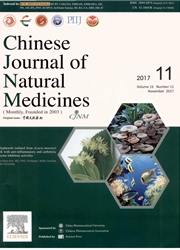

 中文摘要:
中文摘要:
Scutellarin(SCU), a flavonoid from a traditional Chinese medicinal plant. Our previous study has demonstrated that SCU relaxes mouse aortic arteries mainly in an endothelium-depend-ent manner. In the present study, we investigated the vasoprotective effects of SCU against HR-induced endothelial dysfunction(ED) in isolated rat CA and the possible mechanisms involving cyclic guanosine monophosphate(c GMP) dependent protein kinase(PKG). The isolated endothelium-intact and endothelium-denuded rat CA rings were treated with HR injury. Evaluation of endothelium-dependent and-independent vasodilation relaxation of the CA rings were performed using wire myography and the protein expressions were assayed by Western blotting. SCU(10–1 000 μmol·L-1) could relax the endothelium-intact CA rings but not endothelium-denuded ones. In the intact CA rings, the PKG inhibitor, Rp-8-Br-c GMPS(PKGI-rp, 4 μmol·L-1), significantly blocked SCU(10–1 000 μmol·L-1)-induced relaxation. The NO synthase(NOS) inhibitor, NO-nitro-L-arginine methylester(L-NAME, 100 μmol·L-1), did not significantly change the effects of SCU(10–1 000 μmol·L-1). HR treatment significantly impaired ACh-induced relaxation, which was reversed by pre-incubation with SCU(500 μmol·L-1), while HR treatment did not altered NTG-induced vasodilation. PKGI-rp(4 μmol·L-1) blocked the protective effects of SCU in HR-treated CA rings. Additionally, HR treatment reduced phosphorylated vasodilator-stimulated phosphoprotein(p-VASP,phosphorylated product of PKG), which was reversed by SCU pre-incubation, suggesting that SCU activated PKG phosphorylation against HR injury. SCU induces CA vasodilation in an endothelium-dependent manner to and repairs HR-induced impairment via activation of PKG signaling pathway.
 英文摘要:
英文摘要:
Scutellarin (SCU), a flavonoid from a traditional Chinese medicinal plant. Our previous study has demonstrated that SCU relaxes mouse aortic arteries mainly in an endothelium-depend-ent manner. In the present study, we investigated the vasopro- tective effects of SCU against HR-induced endothelial dysfunction (ED) in isolated rat CA and the possible mechanisms involving cyclic guanosine rnonophosphate (cGMP) dependent protein kinase (PKG). The isolated endothelium-intact and endothelium-denuded rat CA rings were treated with HR injury. Evaluation of endothelium-dependent and -independent vasodilation relaxation of the CA tings were performed using wire myography and the protein expressions were assayed by Western blotting. SCU (10-1 000 μmol.L^-1) could relax the endothelium-intact CA rings but not endothelium-denuded ones. In the intact CA rings, the PKG inhibitor, Rp-8-Br-cGMPS (PKGI-rp, 4 μmol.L ^-1), significantly blocked SCU (10-1 000 μmol.L^-1)-induced relaxation. The NO synthase (NOS) inhibitor, NO-nitro-L-arginine methylester (L-NAME, 100 μmol.L^-1), did not significantly change the effects of SCU (10-1 000 μmol.L^-1). HR treatment significantly impaired ACh-induced relaxation, which was reversed by pre-incubation with SCU (500 μmol.L^-1), while HR treatment did not altered NTG-induced vasodilation. PKGI-rp (4 μmol.L^-1) blocked the protective effects of SCU in HR-treated CA tings. Additionally, HR treatment reduced phosphorylated vasodilator-stimulated phosphoprotein (p-VASP, phosphorylated product of PKG), which was reversed by SCU pre-incubation, suggesting that SCU activated PKG phosphorylation against HR injury. SCU induces CA vasodilation in an endothelium-dependent manner to and repairs HR-induced impairment via activation of PKG signaling pathway.
 同期刊论文项目
同期刊论文项目
 同项目期刊论文
同项目期刊论文
 ER stress-mediated apoptosis induced by celastrol in cancer cells and important role of glycogen syn
ER stress-mediated apoptosis induced by celastrol in cancer cells and important role of glycogen syn Scutellarin repairs endothelium dependent relaxation damsge induced by ischemia reperfusion (Abstrac
Scutellarin repairs endothelium dependent relaxation damsge induced by ischemia reperfusion (Abstrac Protective Effects of Scutellarin on Human Cardiac Microvascular Endothelial Cells against Hypoxia-R
Protective Effects of Scutellarin on Human Cardiac Microvascular Endothelial Cells against Hypoxia-R 期刊信息
期刊信息
